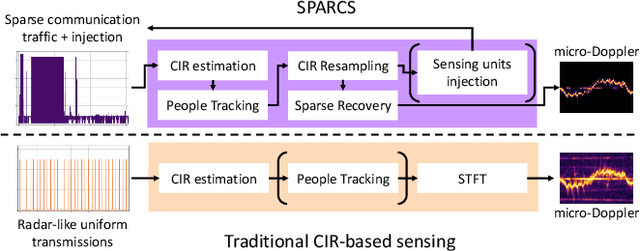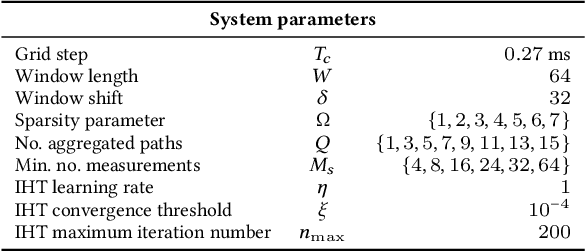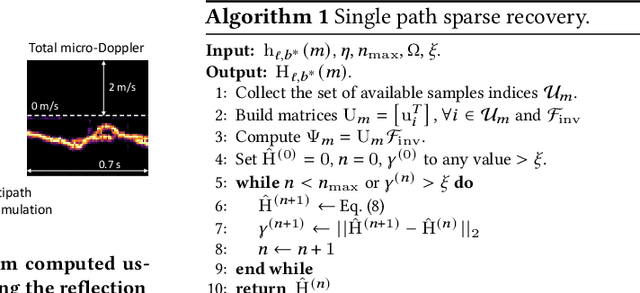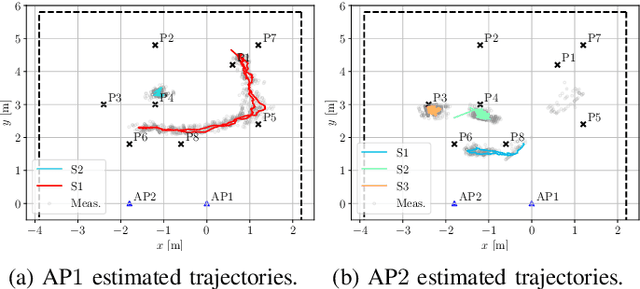Jesus Omar Lacruz
Angle estimation using mmWave RSS measurements with enhanced multipath information
Mar 14, 2024



Abstract:mmWave communication has come up as the unexplored spectrum for 5G services. With new standards for 5G NR positioning, more off-the-shelf platforms and algorithms are needed to perform indoor positioning. An object can be accurately positioned in a room either by using an angle and a delay estimate or two angle estimates or three delay estimates. We propose an algorithm to jointly estimate the angle of arrival (AoA) and angle of departure (AoD), based only on the received signal strength (RSS). We use mm-FLEX, an experimentation platform developed by IMDEA Networks Institute that can perform real-time signal processing for experimental validation of our proposed algorithm. Codebook-based beampatterns are used with a uniquely placed multi-antenna array setup to enhance the reception of multipath components and we obtain an AoA estimate per receiver thereby overcoming the line-of-sight (LoS) limitation of RSS-based localization systems. We further validate the results from measurements by emulating the setup with a simple ray-tracing approach.
DISC: a Dataset for Integrated Sensing and Communication in mmWave Systems
Jun 15, 2023



Abstract:In this paper we present DISC, a dataset of millimeter-wave channel impulse response measurements for integrated human activity sensing and communication. This is the first dataset collected with a software-defined radio testbed that transmits 60 GHz IEEE 802-11ay-compliant packets and estimates the channel response including reflections of the signal on the moving body parts of subjects moving in an indoor environment. The provided data contain the contribution of 7 subjects performing 4 different activities. Differently from available radar-based millimeter-wave sensing datasets, our measurements are collected using both uniform packet transmission times and sparse traffic patterns from real Wi-Fi deployments. Thanks to these unique characteristics, DISC serves as a multi-purpose benchmarking tool for machine learning-based human activity recognition, radio frequency gait analysis, and sparse sensing algorithms for next-generation integrated sensing and communication.
SPARCS: A Sparse Recovery Approach for Integrated Communication and Human Sensing in mmWave Systems
May 06, 2022



Abstract:A well established method to detect and classify human movements using Millimeter-Wave ( mmWave) devices is the time-frequency analysis of the small-scale Doppler effect (termed micro-Doppler) of the different body parts, which requires a regularly spaced and dense sampling of the Channel Impulse Response ( CIR). This is currently done in the literature either using special-purpose radar sensors, or interrupting communications to transmit dedicated sensing waveforms, entailing high overhead and channel utilization. In this work we present SPARCS, an integrated human sensing and communication solution for mmWave systems. SPARCS is the first method that reconstructs high quality signatures of human movement from irregular and sparse CIR samples, such as the ones obtained during communication traffic patterns. To accomplish this, we formulate the micro-Doppler extraction as a sparse recovery problem, which is critical to enable a smooth integration between communication and sensing. Moreover, if needed, our system can seamlessly inject short CIR estimation fields into the channel whenever communication traffic is absent or insufficient for the micro-Doppler extraction. SPARCS effectively leverages the intrinsic sparsity of the mmWave channel, thus drastically reducing the sensing overhead with respect to available approaches. We implemented SPARCS on an IEEE 802.11ay Software Defined Radio (SDR) platform working in the 60 GHz band, collecting standard-compliant CIR traces matching the traffic patterns of real WiFi access points. Our results show that the micro-Doppler signatures obtained by SPARCS enable a typical downstream application such as human activity recognition with more than 7 times lower overhead with respect to existing methods, while achieving better recognition performance.
RAPID: Retrofitting IEEE 802.11ay Access Points for Indoor Human Detection and Sensing
Sep 10, 2021



Abstract:In this work we present RAPID, a Joint Communication & Radar (JCR) system based on next generation IEEE 802.11ay WiFi networks in the 60 GHz band, which retrofits existing communication hardware to perform zero-cost monitoring of human movement and activities in indoor spaces. Most of the available approaches for human sensing at millimeter-waves employ special-purpose radar devices, which are utilized to retrieve and analyze the small-scale Doppler effect (micro-Doppler) caused by human motion. This is key to achieve fine-grained sensing applications such as simultaneous activity recognition and person identification. We show that IEEE 802.11ay Access Points (APs) can be retrofitted to perform radar-like extraction of micro-Doppler effects of multiple human subjects. While radar systems entail the deployment of additional hardware, our framework performs activity recognition and person identification using IEEE 802.11ay wireless networks with no modifications to the transmitted packet structure specified by the standard. We leverage the in-packet beam training capability of IEEE 802.11ay to accurately localize and track multiple individuals using the estimated Channel Impulse Response (CIR), while the beam tracking mechanism embedded in data packets allows to extract the desired micro-Doppler ({\mu}D) signatures of the subjects. We implement our system on an IEEE 802.11ay-compatible full-duplex FPGA platform with phased antenna arrays, which can estimate the CIR from the reflections of transmitted packets. Using two access points, we achieve reliable positioning and tracking of multiple subjects, and an accuracy of 93% and 90% for activity recognition and person identification, respectively.
 Add to Chrome
Add to Chrome Add to Firefox
Add to Firefox Add to Edge
Add to Edge